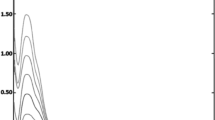Abstract
2,6-Dimethlyaniline (2,6-DMA) is a key starting material which is used in the synthesis of many classes of drugs, such as anesthetics drugs Lidocaine (Xylocaine®), Bupivacaine, Mepivacaine, Etidocaine, Ropivacaine, Pyrrocaine, Xylazine and anti-anginal drug like Ranolazine and anti-diarrheal drug like Lidamidine. 2,6-DMA together with its five positional isomers and related compounds were separated using a simple isocratic and reverse-phase ultra-performance liquid chromatographic (UPLC) method within a shorter runtime. The developed UPLC method was capable to detect and quantify the impurities at lower levels, i.e., Limit of Detection (LOD) 0.007 µg mL−1 and Limit of Quantification (LOQ) 0.02 µg mL−1. The chromatographic separation of the impurities was successfully accomplished on Acquity UPLC CSH Phenyl hexyl (100 mm × 2.1 mm × 1.7 µm) column at a flow rate of 0.3 mL min−1 and signal detection of 210 nm at a sampling rate of 10 points second−1. The column oven temperature was maintained at 40 °C. A mixture of sodium phosphate buffer (10 mM, pH 3.5)—acetonitrile (86:14, v/v) was used as mobile phase with an isocratic mode of elution. Optimization of the chromatographic conditions was carried out by conducting column scouting experiments, studying effect of PH, and organic ratio on individual peak separation. The current method was developed with a systematic approach. Robustness of the developed method was assessed by varying critical factors, such as PH of the buffer, organic ratio, and column temperature, at two levels [low (−), high (+)]. Final method conditions were selected using global desirability with numerical optimization. The resolution (Rs) between each isomer was > 1.5, and column efficiency (N) > 1900 in all the varied conditions. The developed method was fully validated according to ICH Q2 guidelines and USP < 1226 > general chapter requirements.




Similar content being viewed by others
References
Puente NW, Josephy PD (2001) Analysis of lidocaine metabolite 2,6-Dimethylaniline in bovine and human milk. J Anal Toxicol 25:711–715
Yukie M, Kashida Y, Watanabe T, Yasuhara K, Takizawa T, Hirose M, Mitsumori K (2003) Modifying Effects of 2,6-Dimethylaniline on Nasal Carcinogenesis in RasH2 Mice Initiated with 4-Methylnitrosamino)-1-(3-pyridyl)-1-butanone. J Toxicol Pathol 16:41–47
Wenjie Y, Uthpala IS, Ming-Wei C, Ravindra CK, Gerald NW, Steven RT, Paul LS (2012) Transimination of quinone imines: a mechanism for embedding exogenous redox activity into the nucleosome. Chem Res Toxicol 25:2627–2629
Jinping G, Paul LS, Steven RT (2001) Oxidation of 2,6-dimethylaniline by recombinant human cytochrome P450s and human liver microsomes. Chem Res Toxicol 14:672–677
Bonnie L, Carson MS (2000) Local Anesthetics That Metabolize to 2,6-Xylidine or o-Toluidine, Final Review of Toxicological Literature
International Agency for Research on Cancer World Health Organization (WHO), (1993) Occupational Exposures of Hairdressers and Barbers and Personal Use of Hair Colourants; Some Hair Dyes, Cosmetic Colourants, Industrial Dyestuffs and Aromatic Amines, IARC Monographs on the Evaluation of Carcinogenic Risks to Humans 57
Reproductive and Cancer Hazard Assessment Section Office of Environmental Health Hazard Assessment (OEHHA) California Environmental Protection Agency (2002) No Significant Risk Level (NSRL) for the proposition 65 carcinogen 2,6-xylidine
Schmeltz I, Dyer CT, Ratchik E, Matasker J (1982) Separation and determination of xylidine isomers: comparison of gas and liquid chromatographic methods. J Chromatogr A 245:309–320
Ono A (1981) Gas chromatographic analysis of xylidine isomers on heteroaromatic compounds. Chromatographia 14:692–694
Funasaka W, Kojima T, Igaki H (1964) Separation of isomeric xylidine by gas liquid chromatography. Anal Chem 36:2214–2215
Hans GH (1965) Separation of alkylated and chlorinated anilines by gas chromatography. J Chromatogr Sci 3:320–321
Dimple DS, Peter JL, Jennifer AB, (2011) Rapid Analysis of Carcinogenic Aromatic Amines Using the ACQUITY UPLC H-Class SQD System with Empower 3 Software, https://prod1.waters.com/nextgen/pr/en/library/application-notes/2011/Rapid-Analysis-of-Carcinogenic-Aromatic-Amines-Using-the-ACQUITY-UPLC-H-Class-SQD-System-With-Empower-3-Software.html
ICH Q8 (R2) (2009) Pharmaceutical development
FDA guideline (2015) Analytical Procedures and Methods Validation for Drugs and Biologics-Pharmaceutical Quality/CMC
Sergio LCF, Adriana OC, da Thaise SB, Ariana MDSL, Laiana OBS, Walter NLDS (2017) Robustness evaluation in analytical methods optimized using experimental designs. Michrochem J 131:163–169
Saurabh BG, Dinesh MD, Atul AS (2017) Development and validation of simple RP-HPLC-PDA analytical protocol for zileuton assisted with Design of Experiments for robustness determination. Arab J Chem 10:273–282
Avantika VD, Chandra TU, Ekta PB, Punna RR (2018) Design of experiments-based RP—HPLC bioanalytical method development for estimation of Rufinamide in rat plasma and brain and its application in pharmacokinetic study. J Chromatogr B Biomed Appl 1102–1103:74–82
Vishnu MM, Krishnaiah C, Srinivas K, Srinivasa RK, Ramesh KN, Mukkanti K (2013) Development and validation of RP-UPLC method for the determination of darifenacin hydrobromide, its related compounds and its degradation products using design of experiments. J Pharm Biomed 72:40–50
Pierre L, Attilio C, Gabriel C, Eric R, Iolanda N, Radu O, Francisco JR, Coral B, Bruno B, Philippe H (2011) Application of new methodologies based on design of experiments, independent component analysis and design space for robust optimization in liquid chromatography. Anal Chim Acta 691:33–42
Acknowledgements
I am sincerely thankful to the management of ScieGen Pharmaceuticals Dr. P. Malla Reddy and Mr. P.V. Siva Reddy for supporting this scientific research work.
Author information
Authors and Affiliations
Corresponding author
Ethics declarations
Conflict of Interest
The authors declare the absence of conflicts of interest.
Ethical Approval
This article does not contain any studies with human participants performed by any of the authors.
Additional information
Publisher's Note
Springer Nature remains neutral with regard to jurisdictional claims in published maps and institutional affiliations.
Rights and permissions
About this article
Cite this article
Marisetti, V.M., Katari, N.K. Development and Validation of RP-UPLC Method for 2,6-Dimethylaniline, Its Isomers, and Related Compounds Using Design of Experiments. Chromatographia 84, 359–369 (2021). https://doi.org/10.1007/s10337-021-04014-1
Received:
Revised:
Accepted:
Published:
Issue Date:
DOI: https://doi.org/10.1007/s10337-021-04014-1




